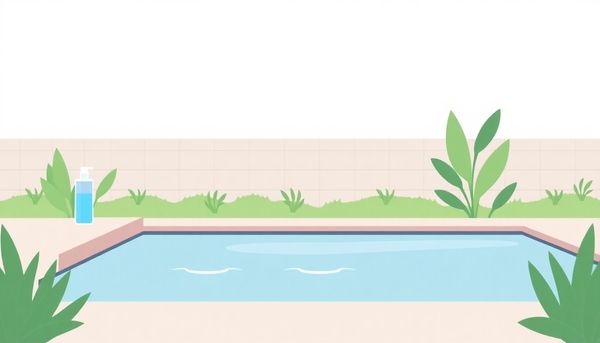Defeat Pool Algae: Essential Tips for a Sparkling Clean Oasis
August 31th, 2024
August 31th, 2024
Sunshine, laughter, and a backyard oasis—pools are the heart of many summer memories. Few things can spoil those joyous splashes more decisively than an unwelcome guest: algae. Suddenly, what was once a crystalline blue retreat becomes a murky green problem. Dealing with algae isn't just about appearances; it's about maintaining a safe and clean environment for everyone to enjoy.
Growing up, I remember how my neighbor's pool would turn into a mini swamp every couple of weeks. They'd try everything: throwing in heaps of chlorine, scrubbing the walls until their arms ached, even considering a complete drainage at one point. Their frustration was palpable, yet algae seemed to have the upper hand. What they needed was not just a quick fix, but a smart, efficient strategy to tackle the root of the problem.
Understanding how algae thrive is the first step towards effective elimination. Algae feed on nutrients and bask in sunlight, turning your pool into their personal playground if left unchecked. With the right approach, however, you can remove these invaders swiftly and efficiently. This guide aims to equip you with practical, tried-and-tested methods to restore your pool's sparkle. By exploring modern techniques and leveraging a few insider tips, you’ll soon reclaim your watery haven, ensuring it's as inviting as the day it was first filled.

Precision is key when dealing with stubborn algae in your pool. Algae can be as elusive as it is persistent, slipping through typical maintenance routines with ease. But fear not; there's a methodical approach to tackle this nuisance effectively. First, acknowledge that traditional chlorine doses won't cut it. Algae spores thrive on loopholes left by low chlorine levels and inadequate filtration, sneaking in through contaminated swim gear or environmental factors like wind and rain. It's imperative to recognize these entry points and address them head-on.
Start by manually vacuuming your pool, bypassing the filter to prevent recirculation of contaminated water. While automatic cleaners might save time, they often miss algae lurking in corners or crevices. Use a sturdy pool brush to scrub walls and floors, paying special attention to shaded areas where algae typically congregate. This physical effort aids in dislodging algae, making it easier for chlorine to penetrate and eradicate it.
Next, recalibrate your pool's water chemistry. Employ test strips or digital kits to check pH and alkalinity levels. This step ensures your pool shock will be at its most effective. A nighttime shock treatment using calcium hypochlorite (cal-hypo) provides the upper hand in your algae battle. The shock should be strong enough to obliterate algae growth without being diminished by sunlight.
Finally, maintain a watchful eye on your pool's filtration system. After the shock treatment, run the filter continuously to clear out dead algae and other contaminants. Regular filter maintenance prevents future outbreaks, and a balanced pool chemistry keeps your water clear and inviting. With these precise steps, your pool can remain a sanctuary, free from the clutches of algae.
Algae in your pool can be as stubborn as a persistent stain on your favorite shirt. It thrives in conditions where chlorine levels dip and water chemistry falters. The moment you see those green, murky patches, it’s time to roll up your sleeves and tackle the problem head-on.
First, equip yourself with a reliable pool vacuum and brush. Manual cleaning might seem like a chore, but it’s key to success. Focus on areas that tend to get less attention—corners, steps, and shaded zones—where algae loves to hide. Scrubbing these areas thoroughly not only dislodges the algae but also allows your pool sanitizer to penetrate more effectively.
Next, turn your attention to the chemistry of your pool. Testing and balancing your water’s pH and alkalinity are crucial steps. A balanced pool creates an environment where algae struggle to survive. Once balanced, it’s time to introduce a pool shock treatment, preferably at dusk or night. This strategic timing ensures the sun doesn’t deplete the chlorine’s effectiveness before it can combat the algae.
Once the shock has performed its magic, run your filter system to remove dead algae remnants from the water. Consider using a clarifier to speed up the clearing process. After achieving crystal-clear water, give your filter a good clean to prevent residual spores from making an unwelcome return.
Preventing future infestations involves consistent maintenance. Regular checks and a little diligence will keep your pool sparkling and algae-free, turning it back into the inviting oasis you deserve.
In the battle against pool algae, mastering the fine art of water chemistry is your best defense. When a friend confided in me about his ongoing struggle with algae, I realized the root of his problem stemmed from overlooking crucial chemical balances. By maintaining the right water chemistry, you can prevent algae from gaining a foothold in your pool. It starts with consistent testing of chlorine levels, pH, and alkalinity. Optimal chlorine levels should hover between 1-3 ppm, while pH should sit around 7.4-7.6. Alkalinity, the unsung hero, must be kept between 80-120 ppm to stabilize pH fluctuations.
Neglecting any of these will open the door for algae spores, carried by rain or dust, to thrive. Remember, high phosphate levels can also act as fertilizer for algae, so don’t forget to check and manage them if necessary. Beyond numbers, ensure your filtration system is up to the task by cleaning it regularly. An efficient filter circulates water, distributing sanitizers evenly and preventing stagnant areas where algae tend to grow.
My friend soon discovered that the secret lay in precision and persistence. By calibrating his pool’s chemistry with care and diligence, he turned his murky water clear again. So, consider water chemistry a guardian of your pool, keeping it algae-free with just a bit of effort and attention.
Wielding a trusty pool brush and manual vacuum might seem old-fashioned in this age of automation, but when it comes to battling pool algae, these tools are your best allies. Remember the last time you tackled a stubborn stain? Manual cleaning techniques rely on the same principle: meticulous attention to detail, ensuring no spot is left unchecked.
Start by giving your pool a thorough brushing. Use a stiff-bristle brush designed for your pool's surface. Concrete pools benefit from stainless steel bristles, while vinyl and fiberglass pools should stick to nylon. Focus on the often-overlooked areas—corners, steps, and shaded regions—where algae love to lurk. As you scrub, imagine you're dislodging tiny algae colonies, making it easier for chlorine to penetrate and do its job.
Next comes the manual vacuuming. Set your pool filter to the 'Waste' setting to avoid recirculating contaminated water. Methodically vacuum the pool floor, maintaining the water level by adding fresh water as needed. This may seem like a workout, but the result is worth it: a pool that's not just clean but sparkling.
Manual cleaning requires patience and dedication but rewards with a pristine, algae-free pool. Think of it as a ritual, a hands-on investment in the sanctuary of your backyard. With each sweep and glide of your brush and vacuum, you're ensuring a clear, inviting oasis for your next swim.

Standing on the edge of a pristine pool, one might mistake its placid surface as a natural deterrent to algae. However, beneath the shimmering water lies a constant battle against these microscopic invaders. Mastering pool algae prevention is not just about chemical warfare; it's a holistic strategy that taps into understanding your pool's unique ecosystem.
First, a balanced pool chemistry is your frontline defense. Regularly testing and adjusting your chlorine and pH levels ensures an environment hostile to algae growth. Consider this akin to tuning a musical instrument; the right balance keeps everything harmonious, while neglect leads to discord—here, in the form of unwanted green patches. My own experience with an unruly backyard pool taught me the importance of maintaining these levels, after a week’s neglect turned our oasis into a swampy lagoon.
Moreover, filtration is more than just a mechanical process. It's the heart of your pool's circulatory system. Thoroughly cleaning the filter on a regular schedule prevents algae spores from making a home within. This is particularly crucial after heavy rains or windy days, when spores are more likely to infiltrate.
Lastly, exercise caution with what enters your pool. Toys and swimwear previously used in natural waters can carry algae spores. A simple rinse before they meet your pool water can save a world of trouble. By embracing these proactive measures, you not only prevent algae but ensure your pool remains a clean, inviting sanctuary all year round.
Balancing water chemistry might sound as complex as a chemistry exam, but achieving it can be quite straightforward with the right approach. Picture your pool as a delicate ecosystem where every drop plays a role in keeping it pristine. The first step is to assess your pool's pH and alkalinity levels, which are crucial in maintaining the effectiveness of your chlorine. High pH levels can render your chlorine less effective, while low alkalinity can cause erratic pH fluctuations. Using a reliable test kit, adjust these levels to fall within the recommended ranges—typically a pH between 7.2 and 7.6, and alkalinity from 80 to 120 parts per million (ppm).
Reflecting on a time when my own pool was more swamp than swim-ready, I discovered the importance of calcium hardness. Too little of it, and you're risking corrosion of your pool surfaces; too much can lead to unsightly scaling. Keeping calcium hardness between 200-400 ppm can prevent these issues. Additionally, never overlook the stabilizer, usually cyanuric acid, which shields your chlorine from the sun’s UV rays. Without it, your chlorine can dissipate rapidly, giving algae the upper hand.
By diligently monitoring and adjusting these factors, you ensure your chlorine is ready to wage war on algae, keeping your swimming haven clear and inviting. Balancing water chemistry may not seem glamorous, but it’s the quiet hero in your pool maintenance saga.
Maintaining a pristine pool is a challenge that requires more than just routine cleaning. One of the most overlooked aspects of pool care is effective filtration, a key player in keeping algae at bay. Picture this: your filter is the lungs of your pool, constantly working to breathe clean life into the water. Without proper filtration, algae spores will have the freedom to flourish, leading to the dreaded green bloom.
Consider the filter as your first line of defense against these microscopic invaders. Regular maintenance is vital. Whether you have a cartridge filter, a sand filter, or a diatomaceous earth (DE) filter, each requires specific attention. For cartridge filters, a simple rinse might suffice for routine cleaning, but a deep clean with a chemical soak can work wonders for peak performance. Sand filters demand backwashing to flush out trapped debris, while DE filters benefit from regular grid inspections and replenishing with new DE powder.
It's also worthwhile to assess the filter's efficiency. Is it the right size for your pool? An undersized filter will struggle to handle the volume of water, allowing contaminants to slip through. Upgrading to a larger filter could save you from future headaches. Remember, a well-maintained filter not only extends the life of your pool system but also keeps algae from gaining a foothold. Think of it as an investment in crystal-clear water and peace of mind.
When it comes to battling algae in your pool, precision is key. Different types of algae require different approaches, much like how a gardener selects specific tools for varied plants. Identifying the kind of algae—be it green, yellow, or black—allows you to tailor your treatment effectively. This is where targeted algae treatments come into play, giving you an edge in this aquatic duel.
Let’s say you’re dealing with green algae. Typically, its swift growth demands an aggressive approach with a hefty dose of calcium hypochlorite shock. On the other hand, yellow (or mustard) algae, notorious for clinging stubbornly to pool surfaces, might require a specialized algaecide designed to tackle its resilient nature. Meanwhile, black algae, with its tough outer layers, often calls for a meticulous combination of brushing and powerful algaecides specifically formulated for its stubborn stains.
This detailed strategy not only streamlines algae removal but also conserves your resources. Imagine using the wrong treatment; not only could it be ineffective, but it might also escalate the problem. By employing targeted treatments, you save time, chemicals, and ultimately, maintain a healthier pool environment. This approach is akin to crafting a personalized battle plan based on your pool's unique challenges. Focusing on understanding your enemy—the algae—ensures a quick, efficient, and successful pool recovery. After all, every pool deserves its own tailored care.

Understanding the intricate dance of pool water chemistry is like mastering a recipe for the perfect summer day. You wouldn’t bake a cake without checking the oven temperature, and similarly, you shouldn’t leave your pool's water chemistry unchecked when battling algae. Algae thrive in poorly balanced pools, so your first line of defense is routine testing. Invest in a reliable test kit—either digital or liquid—to keep an eye on your pool's pH and alkalinity levels.
Consider this: my neighbor once battled stubborn green algae, only to find his pH levels had skyrocketed. After adjusting them with a dose of muriatic acid, his chlorine began to work wonders. Chlorine is the main warrior against algae, but its effectiveness is compromised if your pool's pH and alkalinity aren't within the ideal range. Aim for a pH between 7.2 and 7.6 and total alkalinity between 80 and 120 ppm. These levels ensure that the chlorine can perform its sanitizing magic.
Additionally, pay attention to stabilizer levels, especially cyanuric acid, which protects chlorine from being zapped by the sun. An optimal range of 30-50 ppm is crucial. By maintaining these parameters, you not only prevent algae from gaining a foothold but also enhance the overall quality of your swimming experience. Keeping the chemistry balanced spells fewer headaches and more time enjoying your crystal-clear pool.
Guarding your pool against algae is like protecting a fortress from invaders: vigilance and action are key to maintaining tranquility. Algae prevention starts with a commitment to consistent pool maintenance. Begin by ensuring your chlorine levels are up to snuff, as chlorine is your first line of defense. Regularly test and adjust your pool's pH and alkalinity levels; these parameters should be kept within recommended ranges to discourage algae from settling in.
A robust filtration system is non-negotiable. Schedule regular cleanings for your filters to ensure they efficiently trap debris and microscopic algae spores. Investing in a high-quality filter might seem costly upfront, but consider it a long-term investment in hassle-free swimming.
Remember, algae can hitch a ride on swimwear and pool toys. After a day at the beach or lake, make it a habit to rinse off any equipment before it touches your pool water. This small step can prevent introducing unwanted contaminants.
For added security, consider using an algaecide as a preventative measure, especially during warm months when algae blooms are more common. Opt for a copper-free formula to avoid unwanted chemical buildup in your pool.
Finally, don't underestimate the power of circulation. Keep your pool pump running regularly to ensure water is moving and less likely to stagnate. By taking these proactive steps, you'll create an inhospitable environment for algae, keeping your pool clear and inviting all season long.
A pristine pool is all about keeping its heart—the filtration and circulation system—running smoothly. Just like a car engine needs regular maintenance to perform optimally, your pool's filtration system requires consistent care. Imagine a serene summer afternoon; you're lounging by your pool, with the water shimmering under the sun. That moment of tranquility is made possible by a filter system working tirelessly behind the scenes.
Regular backwashing and cleaning of your filter are crucial. If you're using a sand filter, backwash once a week during peak pool usage. Cartridge filters should be inspected and rinsed every two weeks, and deep cleaning or replacement should occur at least once a season. For a DE filter, don't forget to replace the diatomaceous earth after each backwash. These steps ensure that algae spores and other contaminants don’t sneak back into your pool after being captured.
Moreover, pool pumps are the unsung heroes that maintain water flow, preventing stagnation where algae love to thrive. Running your pump for about 8-12 hours daily keeps the water moving, a requirement for effective filtration. Don’t neglect your pool’s water turnover rate; this should equal the entire volume of your pool every 8 hours.
Consider upgrading to a variable-speed pump if you haven’t already. It’s efficient, eco-friendly, and gives you greater control over water circulation. With these practices in place, your pool will not only sparkle but also fend off algae invasions with ease.
Algae in a pool can feel like an unwelcome houseguest that refuses to leave. When faced with stubborn green intruders, shocking your pool is like a turbocharged eviction notice. It's not just about dumping chlorine and hoping for the best; it's about mastering the art of shock treatment to reclaim your waters. First, identify the type of algae setting up camp—green, yellow, or black. This determines whether you double, triple, or quadruple your shock dose.
Timing plays a critical role. Conduct shock treatments after sunset to prevent the sun from prematurely depleting the chlorine. For the best results, dissolve your shock in a bucket of water before evenly distributing it around your pool. This ensures a more uniform treatment and prevents damage to your pool liner.
While the chlorine is doing its magic, keep your filtration system running all night to circulate the shock. It’s similar to how a fan disperses air in a room, ensuring every corner gets reached. Don't be surprised if your pool water turns a cloudy blue after treatment. This is a good sign that the algae is dead, though it still needs filtering out.
Consider my friend, Jake, who once battled a severe algae bloom. He learned to brush his pool walls before shocking, ensuring no algae hid in crevices. His persistence paid off with a crystal-clear pool ready for summer fun. Following these techniques not only eradicates algae but prevents future invasions, keeping your pool a sparkling oasis.

Maximizing chlorine's power in your pool isn't just about dumping in more chemicals; it's about creating an environment where chlorine can work its magic effectively. Ever noticed how rain can dilute your pool’s chemistry or how a hot streak might invite algae to crash your pool party? This is where maintaining optimal chlorine levels becomes crucial. To ensure chlorine is at its most potent, start by scrutinizing your pool’s pH level. Chlorine becomes less effective in water with a high pH, akin to a superhero weakened by kryptonite. Aim for a pH level between 7.2 and 7.6 for the best results.
Equilibrium in alkalinity is another guard dog for your chlorine. Test your pool’s water regularly, perhaps making a ritual of it every Sunday morning with coffee in hand. This habit not only keeps your water invitingly clear but also puts you in control of any sneaky algae spores thinking of settling down.
Circulation is also key. Make sure your pool pump is running efficiently, ideally for about 8-12 hours daily. This keeps the chlorine circulating, preventing stagnant spots where algae love to lounge. And don’t forget to clean your filter regularly; a clogged filter is like a clogged nose—nothing gets through easily.
By mastering these steps, you’re not just fighting algae; you’re waging a successful campaign to keep your pool clear, healthy, and ready for every splash-filled adventure.
Keeping algae at bay isn't just about maintenance—it's about mastering the art of prevention. Once you've tackled an algae invasion, the focus should shift to fortifying your pool against future outbreaks. Begin by ensuring your pool's chemistry is a fortress. Regularly check chlorine levels, keeping them within the recommended range to fend off the first signs of algae. Maintaining a balanced pH and alkalinity is equally crucial; these factors determine the effectiveness of your sanitizer. Personally, I found that testing my pool weekly not only gave me peace of mind but also saved me from the headaches of algae blooms.
Next, turn your attention to the filtration system. A clean filter is your pool’s best defense. Make it a habit to backwash sand filters or clean cartridge filters regularly, especially during the peak swimming season. Don’t underestimate the power of regular brushing and vacuuming either. These simple acts prevent algae from settling and multiplying in those tricky corners and shady spots.
Finally, be mindful of what enters your pool. Designate a rinse-off area for toys and swimwear, especially if they've been used in natural water. This small step can prevent unwelcome algae hitchhikers from disturbing your pool's tranquility. With these strategies woven into your routine, keeping your pool a sparkling oasis becomes more than a dream; it's your new reality.
When faced with the relentless spread of algae in your pool, it’s clear that maintaining optimal water chemistry is your most reliable ally. By ensuring the right balance of chemicals, you set the stage for a healthier, algae-free pool environment. This isn’t just a matter of convenience; it’s a crucial step in prevention and maintenance.
Start by understanding the chemistry of your pool water. Regularly testing for key indicators like pH, alkalinity, and chlorine levels helps you respond before algae gain a foothold. A pH level between 7.2 and 7.6 is ideal, as it ensures that chlorine works efficiently to sanitize your pool. Alkalinity should hover between 80 and 120 ppm to stabilize pH levels, creating an environment that is inhospitable to algae.
Consider your own experiences: a friend once struggled with persistent algae despite using shock treatments, only to find that high pH levels were undermining her efforts. Once these were corrected, her pool regained its clarity. This highlights the importance of not just addressing the symptoms, but also the underlying causes.
Additionally, pay attention to the calcium hardness and cyanuric acid levels. These elements protect your pool from imbalances that could lead to more than just algae—think corrosion or scaling. By balancing these elements, you’re not just fighting algae; you're crafting a pool environment that naturally resists algae growth and keeps your water invitingly clear.
Mastering the art of pool cleaning can make all the difference when it comes to battling pesky algae. Each step you take — be it scrubbing, vacuuming, or filtering — plays a pivotal role in thwarting these unwanted visitors. Start by dedicating some elbow grease to brushing the pool walls and floor. Often, algae find solace in nooks, crannies, and shadowy corners, so pay special attention to these hiding places. A stiff-bristled pool brush is your best ally, particularly for concrete or gunite pools.
Manual vacuuming should not be overlooked. Sure, automatic cleaners are convenient, but they aren't effective against algae. Manually vacuuming with your filter set to "Waste" ensures that contaminated water exits the pool system entirely. As you vacuum, keep an eye on the water level; topping it up as you go prevents damage to your filter by maintaining adequate water flow.
Beyond the scrubbing and vacuuming, it's crucial to balance your pool's water chemistry. Regular testing of pH and alkalinity ensures your sanitizer works optimally. Personally, I’ve found that a digital test kit provides quick, reliable results, saving time and reducing guesswork. Once balanced, shocking your pool with calcium hypochlorite shock is the next decisive move. Remember, timing matters — shocking at night prevents the sun from depleting the chlorine.
Lastly, don't forget the filter. After such a robust cleaning session, a thorough filter backwash or cartridge cleaning is essential. Neglecting this step could allow dead algae spores to re-enter your pool, undoing all your hard work. Keeping these techniques in mind, maintaining a sparkling, algae-free pool becomes a manageable task rather than a daunting chore.

A clean pool is a happy pool, and when it comes to tackling algae, thorough brushing and vacuuming are your best friends. The battle against algae starts with muscle work: grab a sturdy pool brush and get scrubbing. Algae love to hide in shadowy corners, crevices, and along the floor, so don't be gentle—give those spots a vigorous sweep. The aim here is to dislodge the algae, allowing chlorine to penetrate deeper and perform its magic.
Once the physical scrubbing is underway, it's time to vacuum your pool. Automatic cleaners might seem like a convenient solution, but they aren't designed for algae removal. Instead, you'll want to manually vacuum using your filter's Waste setting. This prevents the algae-infested water from being recirculated, thus ensuring you’re not just moving the problem around.
Maintain the right water level while vacuuming; the water should reach at least halfway up the skimmer to keep the system functioning optimally. If the algae are particularly stubborn, consider using a vacuum head with brushes for a more effective clean. As you work, the water might become cloudy, but that’s a sign you’re on the right track. For those unsure about manual vacuuming, a detailed guide can offer a wealth of tips to simplify the process.
Thorough brushing and vacuuming are crucial steps in your algae eradication strategy, setting the stage for chemical treatments to work effectively. By not skipping these steps, you ensure that your pool remains inviting and algae-free.
Once the vibrant aquatic playground turns into a murky green swamp, it's clear that algae have taken the upper hand. Manual vacuuming is your secret weapon in this battle for clarity. It's an often-overlooked step but a crucial part of the defense against these tiny invaders. While automated systems have their charm, manual vacuuming allows you to be the master of your pool’s destiny, targeting algae with precision.
Start by switching your pool filter to the 'Waste' setting. This bypasses the filter and expels contaminated water, preventing algae spores from making a comeback. As you maneuver the vacuum, focus on those shadowy corners and forgotten crevices where algae love to hide. The process is like a treasure hunt—only the prize is a sparkling pool rather than hidden gold.
It's essential to keep an eye on your water level during this process. Maintaining it halfway up the skimmer ensures that your filtration system operates efficiently. Remember, the key here is patience and thoroughness; the more meticulous you are, the fewer algae will remain.
When I first took on the task of manual vacuuming, it felt like a chore. However, as I saw the clear water surface returning, it became a gratifying ritual. Each session ended with a sense of accomplishment and the quiet promise of a refreshing swim. Embrace this step, and your pool will thank you with crystal-clear waters, free of unwelcome green visitors.
Tackling algae growth on pool walls might feel more like a chore than a refreshing swim, but with the right approach, it becomes an essential part of maintaining your pool’s health. The task calls for more than just elbow grease; it's about being strategic in your cleaning efforts. Begin the process with a sturdy pool brush attached to a long pole. This will give you the reach necessary to tackle those hard-to-see spots that algae love. Corners, crevices, and shady areas are prime real estate for algae, so focus your efforts there first.
When it comes to choosing your brush, the material of your pool walls dictates your decision. Concrete or gunite pools benefit from a stainless steel bristle brush, which effectively scrapes away stubborn algae. For more delicate surfaces like vinyl liners or fiberglass, opt for a nylon bristle brush. Its gentler touch ensures you don’t damage the finish while still dislodging the pesky algae.
Remember, as you scrub, the water can become cloudy with loosened particles. This is a sign that you’re doing it right, lifting the algae so it can be filtered away. It’s wise to tackle the toughest spots initially to make sure they receive the most attention before your visibility decreases. Once the brushing is complete, your pool will be ready for the next steps of water treatment and filtration, ensuring those spores don’t stand a chance.

This article provided insights into maintaining your pool. Start your pool care journey today!
Want to become a pool maintenance expert? Our free Pool School course covers everything you need to know about pool care. From basic maintenance to advanced troubleshooting, you'll learn how to:
Join over 10,000 pool owners who have already transformed their pool care routine. Get started with our free Pool School course today!